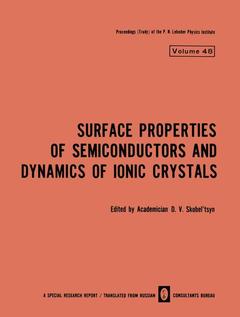Description
Surface Properties of Semiconductors and Dynamics of Ionic Crystals, 1971
The Lebedev Physics Institute Series, Vol. 48
Coordinator: Skobel tsyn D. V.
Language: English
Keywords
Publication date: 06-2012
184 p. · 21x27.9 cm · Paperback
184 p. · 21x27.9 cm · Paperback
Contents
/li>
Investigation of The Nature of The Dominant Recombination Centers on The Real Surface of Germanium. Yu. F. Novototskii- Vlasov.- I. Electron Processes on the Surface of a Semiconductor.- 1. Surface States.- 2. Surface Conductivity.- 3. Surface Recombination.- II. Investigation Methods.- 1. Field Effect Method.- 2. Measurement of the Surface Recombination Velocity.- 3. Steady-State Photoconductivity Method.- 4. Combined Measurement Method.- 5. Optical System.- 6. Measuring Circuit.- 7. Thermostatting of the Sample.- 8. Heating of the Sample by a Current.- 9. Preparation of the Sample..- 10. Vacuum and Gas Admission System.- III. Experimental Results.- 1. Heating in Vacuum. Polar Molecules.- 2. Effect of Ozone on a Freshly Etched Germanium Surface.- 3. Heating in Vacuum to 650°K.- 4. Effect of Ozone on a “Dehydrated” Surface.- 5. Influence of Water Vapor after Heating above 500°K.- 6. Heating at High Temperatures.- 7. Heating at High Temperatures in Oxygen and Ozone.- IV. Discussion.- 1. Analysis of Experimental Data.- 2. Nature of the Compensating Effect of Water.- 3. Nature of Recombination Centers on Real Surface of Germanium.- Conclusions.- Literature Cited.- Theory of Electromagnetic Wave Absorption in Ideal and Nonideal Ionic Crystal Lattices. V. S. Vinogradov.- I. Review of Work on the Theory of Electromagnetic Wave Absorption by Ideal and Nonideal Crystal Lattices.- 1. Classical and Quantum Theories of Infrared Absorption and Dispersion in an Ideal Ionic Crystal Lattice.- 2. Theories Which Take Account of the Influence of Charged Defects on Electro- magnetic Wave Absorption by a Crystal Lattice.- II. The Hamiltonian and the Equations of Motion. Expression of the Complex Polarizability in Terms of Retarded Green’s Functions.- 1. The Hamiltonian for a Lattice Containing Defects. Properties of Its Coefficients..- 2. Expression for the Complex Polarizability of the Lattice in Terms of Retarded Green’s Functions.- 3. The Phonon Creation and Annihilation Operators. The Hamiltonian and the Polarizability in Terms of These Operators. Equations of Motion for Operators.- III. The Quantum Theory of Infrared Absorption and Dispersion in an Ideal Ionic Lattice.- 1. Equations for the Retarded Green’s Functions.- 2. Solution of the Equations for the Green’s Functions.- 3. Discussion.- IV. Absorption of Microwaves in an Ionic Crystal Lattice Containing Charged Defects.- 1. Equations for the Retarded Green’s Functions.- 2. Solution.of the Equations for the Green’s Functions. Expression for the Imaginary Part of the Complex Polarizability.- 3. Calculation of the Coefficient ?? (vi -i~y).- 4. Calculation of ?j?(vi-yi y-vi)o q(y-vi).- 5. Expressions for the Imaginary Part of the Permittivity in the Case of Point and Linear Charged Defects.- 6. Discussion of the Results. Comparison of Theory and Experiment.- Conclusions.- Appendix A. The form of the Coefficients ?(yy’…y(n))(ii’… i(n))º and ?? (yy’…y(n))(ii’… i(n))º for Forces between Pairs of Ions.- Appendix B. Calculation of the Polarization Vectors w?(k| yj)and the Frequencies ?(yj) for Small |y| in the Isotropic Case.- Appendix C. Applicability of the Born Approximation in Calculating the Scattering of Lattice Waves by Charged Defects.- Literature Cited.- Vibrational Spectra of Strontium, Barium, and Calcium Titanates. V. N. Murzin.- I. Introduction.- 1. Vibrational Spectrum of SrTiO3-Type Crystals.- 2. Features of the Vibrational Spectra of Perovskite Ferroelectrics..- II. Experimental Method.- 1. Spectrophotometer for the Far-Infrared Region.- 2. Method of Measurement in the Submillimeter and Radio Ranges.- 3. Method of Preparation of the Samples.- III. The Spectrum of Normal Modes of Vibration in Crystals of Perovskite Type.- IV. Experimental Results and Their Interpretation.- 1. Transmission and Reflection Spectra.- 2. Determination of the Spectral Variation of the Complex Permittivity. The Vibrational Spectrum of SrTiO3, BaTiO3, and CaTiO3.- 3. Dielectric Dispersion of SrTiO3, BaTiO3, and CaTiO3 Polycrystals over a Wide Frequency Range.- 4. Temperature Variation of the Vibrational Spectrum of BaTiO3.- V. Vibrational Spectra of Some Crystals Having Near-Perovskite Structure.- VI. Derivation of the Dispersion Relation and Some Microscopic Properties of BaTiO3.- Conclusions.- Appendix. Determination of the Symmetry Coefficients from the Known Transformation Matrices.- Literature Cited.
© 2024 LAVOISIER S.A.S.




